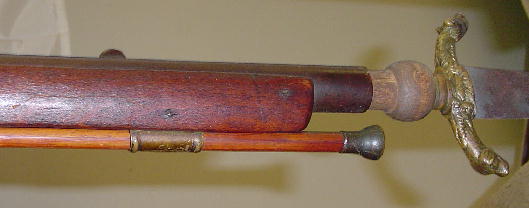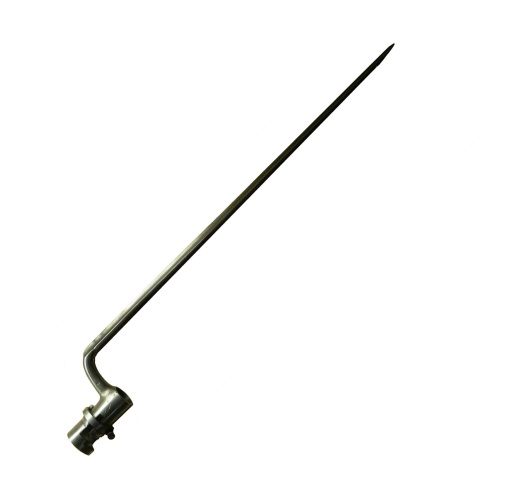How Did They Repair Bayonets In Revolutionary War
The bayonet transformed the musket from a medium to long range weapon into i effective at shut range as well. There was no longer a need for pikemen to defend musketeers in battle because ane soldier could defend himself confronting an enemy less than 100 yards away. The bayonet was primarily used during cavalry charges and in close range combat. The weight, shape and attachment of bayonets accept inverse throughout history in society to increase the effectiveness of the musket and the bayonet.
The commencement use of bayonets was simply a knife stuck on the end of a musket barrel used by French hunters catching wild boar. This combination was then used in warfare, and became known as a plug bayonet. Though an effective weapon, a downside of the plug bayonet was that the musketeer could not shoot afterward affixing it. The plug bayonet was succeeded by the socket bayonet, which fit over the muzzle of the butt. A zig-zag motion around the bayonet lug allowed the musketeer to easily affix or remove the bayonet while still securing information technology in identify. The major advantage to the socket bayonet was that the musket could still be fired while the bayonet was attached. To overcome the fact that not all soldiers used the same weapon, or weapons with the same butt sizes, the socket bayonet was modified to have a split up down the side. An intentional slit running the entire length of the socket immune for an adaptable fit of the socket to the size of the butt. Unlike the plug bayonet, the socket and split-socket bayonets had 3 edges, giving them the name "triangular bayonets". Given forging processes at the fourth dimension, a triangular bract was easier to create, and offered increased stability from a 2 sided or knife bract bayonet without much boosted weight. During the War of 1812, bayonets for the British Brown Bess, French Charleville, and Usa Springfield muskets were between 12 and 15 inches in length, and continued to have the triangular shape.
Socket bayonets were used through the middle of the 20th century; however the triangular shape became obsolete after the belatedly 1800's. Though many claim that the triangular bayonet was outlawed in the Geneva Convention in 1949, this is actually not the case. The Geneva Convention set many of the rules of war, and in response to bayonets it prohibits "bayonets with a serrated edge" (International Committee of the Crimson Cross). Triangle bayonets are not explicitly mentioned in the Convention. Since the wound inflicted by triangular bayonets is difficult to repair, and causes more than initial bleeding than that of a two sided bayonet, i could classify triangular bayonets under a clause which prohibits weapons causing undue suffering after the conflict has ended. Indeed, the wounds acquired past a triangular bayonet were recorded to terminal for years later on a battle, or to never heal at all. However this would exist a stretch. Prior to the mid-1900's, this also meant that the wound was peculiarly prone to condign infected, the principal crusade of deaths in the War of 1812.

Case of a plug bayonet showing the end of a pocketknife inserted into the cage of a musket.

A socket bayonet, complete with retaining ring for added security.
In 19th Century warfare, including the War of 1812, bayonets were primarily used to drive the enemy from the field. The victor of a battle was the one controlling the land when all was said and done. Though the wounds from bayonet stabbings were barbarous, less than 3% of casualties during the war were actually from bayonets (CITE). This is because the opposing side often dispersed as they were being charged.
Today bayonets are not used commonly in the U.s. Armed services; the Marines are the only branch of the US Military who nonetheless include bayonet assault training in their basic training course. Around the earth bayonets are used as a shut range weapon and as a utility tool. Even so because of engineering science changes, many of our conflicts are at present fought at farther distances, and bayonets are becoming obsolete.
References
Forsyth, Justin. "Triangular Bayonets." A Changing of Ideals: From Bayonets to Drones. N.p., north.d. Web. 18 July, 2022.
Whittle, John. "History and Evolution of the Bayonet." The Armoury Online. N.p., 5 July 2006. Web. 18 July 2022.
International Commission of the Cerise Cantankerous. International Committee of the Red Cross, 2022. Web. xviii July, 2022.
Schloesser, Kelly. "2010 Brings Major Transformation to Basic Combat Training." U. S. Army. 19 July 2010. Web. 21 July 2022.
"Marine Bayonet." Marines.com. The states Marine Corps, 2022. Spider web. 21 July 2022.
Plug Bayonet. Digital image. Firearms history, Engineering, and Development. N.p., 8 July 2022. Spider web. 21 July 2022.
Socket Bayonet. Digital image. Firearms history, Engineering science, and Development. North.p., 8 July 2022. Web. 21 July 2022.
How Did They Repair Bayonets In Revolutionary War,
Source: https://www.nps.gov/pevi/blogs/a-brief-history-of-the-bayonet.htm
Posted by: cavanaughtatem1950.blogspot.com


0 Response to "How Did They Repair Bayonets In Revolutionary War"
Post a Comment